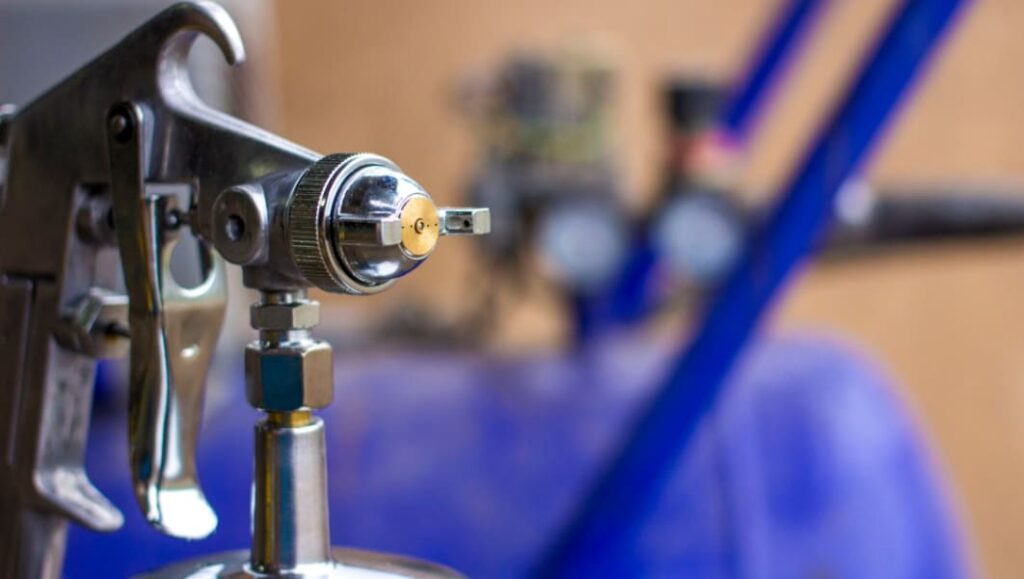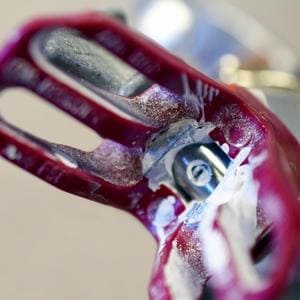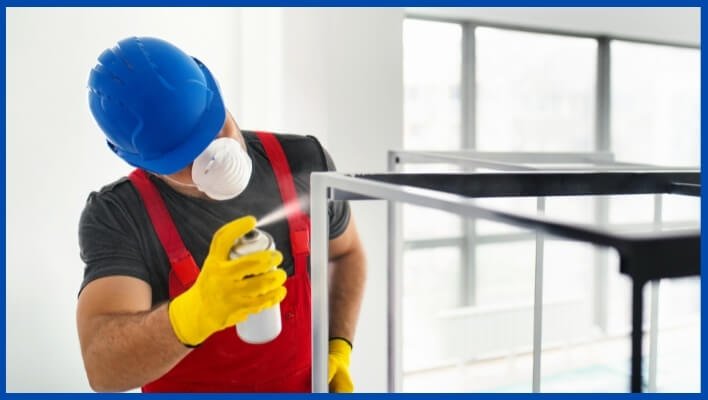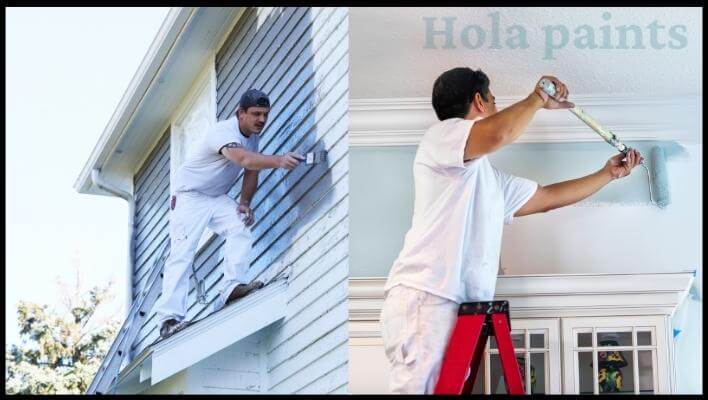DIYers and professionals alike use paint sprayers, but when they become clogged, they can be frustrating especially if you’re not familiar with the proper methods. Fortunately, with the right approach, you can unclog your paint sprayer quickly and efficiently. We will walk you through the step-by-step process of unclogging a paint sprayer with practical examples and tables outlining common problems and solutions.
To begin with, it’s important to note that the method of unclogging a paint sprayer differs slightly based on the type of sprayer. However, the fundamentals remain the same. This article will share some tips and tricks on how to unclog a paint sprayer so that you can move on to your next project.

Table of Contents
- Signs of a Clogged Paint Sprayer
- Tools You Will Need To Unclog A Paint Sprayer
- Step 1: Identify the Problem
- Step 2: Unplug and release the pressure
- Step 3: Clean the Filter
- Step 4: Clear the Tip
- Step 5: Reassemble the sprayer
- Conclusion On How To Unclog A Paint Sprayer:
- FAQS On How To Clean A Clogged Paint Sprayer
- What causes a paint sprayer to clog?
- How do I unclog my paint sprayer?
- Why does my paint sprayer pump water but not paint?
- Can I prevent my paint sprayer from clogging?
- How often should I clean my paint sprayer?
- Why is paint not coming out of my sprayer?
- Why is air coming out of my spray gun but no paint?
Signs of a Clogged Paint Sprayer
The signs of a clogged paint sprayer include:
| Problem | Cause | Solution |
| Paint spitting | Low pressure or thick paint | Adjust pressure or thin the paint |
| Uneven spray | Clogged tip or dirty filter | Clean the tip or filter |
| No spray at all | Clogged hose or worn-out pump | Clear the hose or replace the pump |
| Drips or runs | Incorrect viscosity or worn-out gasket | Adjust viscosity or replace the gasket |
If you notice any of these signs, your paint sprayer is likely clogged, and you need to unclog it before you can continue painting.
TIP: When you notice a clog in your paint sprayer, you should stop using it. If the sprayer is continued to be used, it can cause further damage and become harder to unclog.
Tools You Will Need To Unclog A Paint Sprayer
To unclog a paint sprayer, you will need the following tools:
- Paint thinner
- Bucket
- Cleaning brushes
- Wrench or pliers
- Safety glasses and gloves
Let’s look at some practical solutions for unclogging a paint sprayer.
Step 1: Identify the Problem
It is important to identify the problem before unclogging a paint sprayer. Depending on the paint thickness, the tip’s cleanliness, and the paint buildup in the hose, clogs can occur. The majority of these issues can be avoided through regular maintenance, but sometimes clogs do occur.
The table below illustrates that several reasons can lead to a clogged paint sprayer.
| Problem | Causes |
| Use of the wrong type of paint | It is important to consider the type of paint you are going to use before using a paint sprayer to reduce the likelihood of clogging. Paints such as latex or enamel can easily clog a sprayer if not thinned properly. |
| Dirty Nozzle | The most common cause of clogged paint sprayers is a dirty nozzle. If the nozzle becomes dirty or has residue buildup, paint can not flow smoothly. |
| Incorrect pressure settings | A wrong pressure setting can cause the paint to come out too fast or too slowly, clogging the machine. |
| Dried paint residue | Paint can dry inside the nozzle or other parts of your sprayer if it isn’t cleaned properly after each use. |
| Debris in paint | Even after straining paint, small particles or clumps can clog the nozzle or hose of the sprayer. |
| Faulty parts | Hoses and nozzles can become worn or damaged over time, resulting in clogs. |
When you identify the specific problem, you can select the right solution and avoid wasting time.
Step 2: Unplug and release the pressure
To unclog your paint sprayer, disconnect it from the power source and let it air out. In this way, you will be able to work with the sprayer safely and prevent any potential accidents from occurring.
Step 3: Clean the Filter
The filter removes debris from paint, but becomes clogged after repeated use. Rinse the filter with warm water after removing it from the sprayer. In some cases, a soft-bristle brush may be required to get rid of debris from heavily clogged filters.
Step 4: Clear the Tip
Paint accumulation at the sprayer tip is a common issue that requires attention. Soak the clogged tip in warm water for 10-15 minutes and use a small brush to remove any remaining debris. If necessary, the tip can be replaced in extreme cases. Afterward, clean the sprayer body with a cleaning solution to flush out any remaining paint or debris. It is also possible to clean the tubing with a small brush or a pipe cleaner.

Step 5: Reassemble the sprayer
Clean all the parts of the sprayer and reassemble it. Test it out with some water. You can use this technique to verify that the clog has been successfully removed and that the sprayer is working correctly.
Conclusion On How To Unclog A Paint Sprayer:
In summary, cleaning a clogged paint sprayer requires care and attention. You can extend the life of your paint sprayer by taking proper care of it and maintaining it.
When you encounter a persistent clog or are unsure of any part of the unclogging process, consult your manufacturer’s instructions or seek professional assistance.
I hope this guide has been helpful to you and that you have learned something new about how to unclog a paint sprayer.
FAQS On How To Clean A Clogged Paint Sprayer
What causes a paint sprayer to clog?
Sprayers can become clogged for a variety of reasons, such as when the paint is too thick or contains debris, when the nozzle is worn or damaged, or when the sprayer is not adequately cleaned.
How do I unclog my paint sprayer?
Turn your paint sprayer off and remove the nozzle to unclog it. Clean the nozzle and filter with warm soapy water or with a specialized cleaning solution. Any remaining debris may need to be gently removed using a pin or wire. Lastly, ensure that the sprayer is working properly by reassembling it and testing it.
Why does my paint sprayer pump water but not paint?
If a paint sprayer pumps water but not paint, it may be due to improper paint viscosity, a clogged nozzle or filter, air in the system, worn or damaged parts, or incorrect setup. Check these factors and make adjustments as necessary to allow paint to flow.
Can I prevent my paint sprayer from clogging?
You can prevent clogs by using the correct paint viscosity for your sprayer. You can also strain paint before use, and thoroughly cleaning your sprayer after each use.
How often should I clean my paint sprayer?
Cleaning the paint sprayer after every use is recommended to prevent clogs. If your sprayer is not used frequently, you still need to clean it thoroughly before storing it to prevent residue buildup.
Why is paint not coming out of my sprayer?
You may have several reasons why paint is not coming out of your sprayer, including:
- A clogged nozzle is one of the most common causes of sprayers not working. When the nozzle becomes clogged, paint cannot flow through the sprayer.
- A low paint level can cause air to enter the sprayer system, which block the flow of paint.
- Wrong paint viscosity: If you use too thick or too thin paint, the sprayer will clog, and you won’t be able to spray.
- Wrongly mounted nozzles or damaged pumps can make the sprayer inoperative.
- Incorrect pressure settings and airless tips can cause paint not to come out of a sprayer.
To troubleshoot the issue, check the nozzle, paint level, viscosity, and parts for any damage or wear. In addition, you should ensure that the sprayer is set up correctly and that the settings are correct.
Why is air coming out of my spray gun but no paint?
The reason why you might be getting air out of your spray gun but not paint is because of a few factors. One possibility is that the paint viscosity is too thick for the nozzle size or air pressure. This prevents the paint from being atomized appropriately. Another possible cause could be a clogged nozzle, preventing paint from flowing. Make sure you troubleshoot these issues and adjust your settings accordingly.

Rosalie Sanchez
DIY enthusiast with years of experience in home decor and home improvement. With a passion for educating consumers about DIY projects. Every time, I work with our painting professionals to provide you with the best painting product reviews and how-to advice. You can follow me on Facebook.


